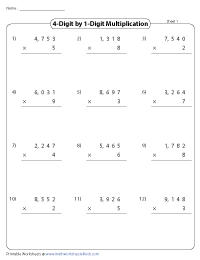- Worksheets>
- Math>
- Number Sense>
- Multiplication>
- 4-Digit by 1-Digit
4-Digit by 1-Digit Multiplication Worksheets
Supercharge skills with our 4-digit by 1-digit multiplication worksheets with answer keys where kids solve standard problems and apply their skills to solve real-life word problems. Exercises like multiplying four digits times one-digit whole numbers in columns, finding the product using place value charts, grids, and area models, and finding partial products make this PDF resource a must-have! Give your practice a head start with our free worksheets.
Column Multiplication | 4-Digit by 1-Digit Numbers
Get children to solve 4-digit by 1-digit multiplication questions arranged in columns to reinforce their place value skills and accuracy.
Multiplying 4-Digit Numbers by 1-Digit Numbers
Grade 4 and grade 5 kids multiply 4-digit numbers between 1000 and 9999 by factors limited to 9 presented in standard column format and as real-life word problems.
Exclusive Word Problems | 4-Digit by 1-Digit
Bridge the gap between concept and application with these 4-digit by 1-digit multiplication worksheets. Identify the factors, build the multiplication equation, and find the product.
Multiplying 4-Digit Numbers by 1 Digit Numbers Using Grids
Develop kids’ understanding of multiplying 4-digit numbers by 1-digit numbers using grids. Each digit is arranged according to its place value on the grid, helping kids visualize the process clearly.
Multiplication of 1-Digit Numbers by Multiples of 1000
Tackle questions like “How much is seven times one thousand?”. Read each real-life scenario, identify the single-digit whole numbers and the 4-digit multiples of 1000, and find the product.
Multiplying Using Place Value Chart | 4-Digit by 1-Digit
Each problem is presented as a horizontal multiplication equation. Line up the 4-digit numbers on the grid based on the place value chart and multiply the numbers.
Finding Partial Products | 4-Digit by 1-Digit
Break apart each 4-digit number and multiply each separately to find partial products. Combine the partial products to find the final product in these multiplying 4 digits times 1-digit worksheets.
Multiplying Using Area Model | 4-Digit by 1-Digit
The 4-digit numbers are split based on place value. Multiply each place value with the single digit number and write the partial products. The sum of the partial products yields the final product.








